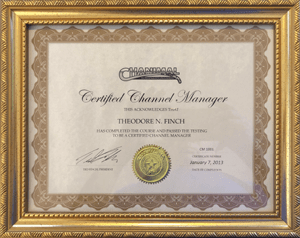Channel Marketing in 2023
Channel marketing can vary according to the channel type–retail has some specialized differences, but otherwise, the roll is similar. It’s easiest to define it by what channel marketing does–through the channel marketing manager. It also helps to explain the different roles.
Roles of the Channel Marketing and Channel Sales Team
A Channel Marketing Manager is typically hired first. Initially, they help with the channel definition, setup, and orchestration, but they later extend as a Regional Marketing Manager once resellers are on-board to help the accounts with regional promotions (working with resellers in their respective areas). They would have a marketing background and report to the marketing department. Some sales experience is always helpful, so they relate to the mindset of sales and respect the differences. Channel Marketing owns the program. They are also responsible for overall partner sell-through. Responsibilities include:
- Establish a competitive reseller program (define the structure, agreement, policies (lead, MDF/Co-op, deal registration), margins, levels, etc.)
- Create the reseller collateral (create the portal, market info, price list, PowerPoint, 25/50 description, product slick, competitive matrix, white papers, case studies, graphics, sell sheets, packaging (if retail)), training & certification material, etc.
- Setup and manage the recruiting database
- Mass recruiting – create and send emails, channel ads, press release, alliances
- Questions, up-front product demos to prospective partners
- Manage reseller database (or PRM) – ensure clean consistent data, integration, analytics
- Initial setup (add to portal, acceptance email, NFR access)
- Orientation meeting (product demo, portal overview, know how to order)
- Marketing meeting (get the product on the website, put on reseller locator, first direct email campaign (driving to a webinar), promotional schedule)
- Ensure proper merchandising (retail only)
- Setup and manage reseller product training and certification (minor for retail, detailed for VARs and Integrators—so can handle 1st & 2nd line support)
- Collaborate on reseller promotions – act as their regional marketing manager
- Send resellers leads & track follow-up
- Jointly manage and invest in market development with MDF & Co-op budgets to increase channel sell-through
- Newsletter – keep partners up to speed on the product and program updates, promotions, wins, new collateral, wins, etc.
- Contest – work with sales to run channel contest, spiffs, rebates, specials & motivation
- Sales Meetings – national (webinar or on-location)
- Marketing team – they are also part of the marketing team and participates with Product Marketing, PR, the Webmaster (for the reseller portal and reseller SEO for landing pages) and Advertising to ensure that the specific reseller needs are met.
The Channel Sales Manager (hired up-front for retail, but after the program is defined and reseller recruiting begins—for VARs, etc.) and reports into Sales. He should have direct sales, sales management, and channel sales experience. Channel sales owns the “people” and personal relationship. The role is responsible for considerably fewer elements than channel marketing but fills the critical CLOSING role (no sales and the entire program has no value).
- Personally, learn how to sell the product
- Do the phone call follow-ups to resellers with lots of sales questions and GET them to apply and ensure they get into the orientation meetings.
- Cold call the reseller list to recruit directly
- Once the reseller is on-board, their primary role is to act as a SALES manager and help the channel to SELL (model calls, coaching calls, joint visits, objections, motivation, help with high-end quotes)
- Help coordinate sales promotions through the partners
- If in retail, their job is sell-in. They must sell the product into distribution and into the retail outlets (local, regional and national), plus maintain the overall account relationship. Then channel marketing helps execute the channel and product promotions to effect sell-through.
Retail Channel Marketing
In retail, Channel sales is the overall account liaison and is primarily responsible for selling product into distribution and the reseller channel (local, regional and national chains). Channel marketing is responsible for ensuring that product in distributor and reseller locations gets sold out (sell-through).
There are cases where a Channel Marketing Manager handles all sell-in and sell-through via the channel, and the internal salespeople concentrate on selling direct–this may vary according to your organization.

What is a Channel?
We’ve defined the roles above, but it may not make sense if you don’t know what a channel is. A channel to market is the method of getting your product into the customer’s (the end user’s) hand. This can either be through direct sales or through a reseller. Direct sales can occur in person, via the phone, the web or mail. Indirect, or channel sales typically refers to sales through a reseller. A reseller can order from you direct (one-tier between you and the end-user), or from a wholesale distributor–you would sell to a wholesale distributor and they, in turn, would sell to multiple resellers (two tiers between you and the end-user (hence the common term “two-tier” distribution)).
Note: some companies or divisions (i.e., Motorola semiconductor, etc.) call the reseller the distributor (or disty)–this is correct, but not in the typical and more common two-tier distribution model. Hence, it is important to get the channel terminology down whenever talking about the channel–or you could be in violent agreement, and not even know it.
Also check out Channel Sales (Distributors, Reseller Types, Rep Firms, Agreements, and International)
Which Channel to Use?
The first question to address is whether you should go direct or indirect. Often the answer is both–especially since the popularity of the Internet. The key, however, is to avoid most of the channel conflict.
Channel conflict occurs when the vendor (you) and the reseller, or different reseller types (retail, VAR, mail order, Internet) compete for the same business. I say “most” of the channel conflict, since it is fine to have some conflict–resellers may compete, and there may be some of the business that you can take direct. For example, you might go direct with massive deals that are too big for a reseller to finance (such as a 1.3 billion deal overseas I had at Motorola), or very small deals that don’t require any special training/installation/consulting–hence won’t provide margins for your resellers who make money on their ‘value-added’ services.
To minimize conflict, the channel marketing manager could:
- Segment the products (different products are sold through different reseller types or channels)
- Setup exclusive or limited territories (works best for dealership models–but NOT for resellers that work regionally or nationally)
- Sell direct at a higher price than the average street price
- Setup different promotions for different resellers–rotating so they all have advantages at different times
- Provide MDF/Co-op and let the resellers choose to establish their own competitive advantage
- Setup reseller levels–rewarding higher margins and support for higher authorization (the resellers choose whether they can be competitive)
- Set up a process to determine if a customer has worked with a reseller prior to taking the business direct (so you don’t steal business they cultivated), etc.
There are multiple ways that a channel marketing manager can reduce conflict–the key is to be aware that it could exist and of your ramifications (short and long-term), and that you do something about it to keep your reseller and revenue targets satisfied.
One vendor long gone, Ashton Tate, had a terrible problem with channel conflict (they would sell direct and undercut a prospect the reseller had cultivated)–as a result, their resellers hated them. They still sold their products since they were so popular (dBase), but were rooting for a competitor to take them out–which happened.
It is also a problem if you have no conflict since it usually indicates that you don’t have enough sales coverage–there could be parts of the market you are not covering (missing RFQ’s, not knowing about the opportunities, your product is not sold where the customers traffic, etc.).
Direct or Indirect Channel?
The question to go direct, indirect or both is often determined by the following:
- Ability to recruit resellers. If you cannot get your product into distribution, or find resellers, the answer is simple, you go direct.
- Product type. If you are selling a product that requires a lot of training, installation, and support, you may go direct until you get your resellers trained and certified–or, if you have a large enough sales force, you may stay direct. However, if you have enough salespeople to only cover the largest customers (10 salespeople to cover top 100 telcos, but not enough to cover the middle 5,000 VARs), you may wish to use resellers to cover the middle market–then segment your product line, one for direct and one for resellers.
- Market dynamics. As the market technology adoption changes and products that used to require support become easier to use, and customers know what they want–you may go direct (like Dell (it was actually a modest model in the early days, since most users needed more support but became effective
- Price point. High-end premium quality consumer products (such as expensive cookware, the best vacuums, etc.) are sometimes sold direct (and usually person-to-person) since the benefits (which are real, but not always obvious) must be sold. However, this does not mean that high-priced products can’t be sold via the channel (boats, planes, million-dollar SFA products, etc.).
- Customer requirements. Some customers mandate a direct relationship with the vendor to ensure their needs are met. In some cases, when an account insists ongoing direct, the reseller can still earn a bounty for delivering the qualified, pre-sold lead.
- Ability to manage resellers. Much of the decision to go direct or indirect is also dependent on the companies ability to understand how the channel functions, come up with a competitive program and manage the reseller programs and relationships.
The final decision on direct or indirect is based on your business model and how you address the questions above.
Additional Channel Marketing Information
Note: The Product Marketing Handbook contains several chapters on channel marketing (much of the content and templates in the CD was contributed by Chanimal). In addition, the author, Rick Chapman, is also the co-author of The US Distribution Guidebook, published originally by the Software Publishers Association. I highly recommend you get a copy!
Contact Info
Chanimal, Inc.
12109 Lake Stone Dr
Austin, TX 78738
512-263-9618
Click HERE to Email
Follow us on Facebook
NOTICE
I join a LOT of affiliate programs (connoisseur–like to see what they do), including Amazon, so there may be links throughout Chanimal.

